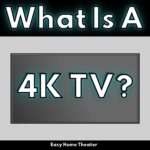Micro LED VS OLED – An Interesting Potential
Micro LED VS OLED – An Interesting Potential

I know I say this a lot, but this truly is going to be an interesting one.
Folks, today we have Micro LED vs OLED!
Chances are you may not be familiar with the former, (or possibly the latter) but just know that it’s extremely exciting since Micro LED is a display technology with the potential to set a new visual benchmark.
However, let’s take a look at both technologies to see how they differentiate.
What Is OLED?
OLED is actually an acronym that stands for organic light emitting diode.
It’s basically just a fancier way of saying its a compound capable of producing its own light when given power.
How Does It Work?
Now the way that it works is actually really cool.
Without getting too in depth, (because it can get pretty complicated) for every pixel, when an electrical current passes through it, it glows a specific color depending on the filter being used for that pixel.
This is where things get really interesting though.
Whereas the average television today uses a backlight to produce a picture; an OLED doesn’t.
Instead of a backlight, each individual pixel acts as it’s own backlight in a sense.
So when an electrical current is detected, it lights up.
Also, unlike an LCD display where other nearby pixels light up when one is active, with OLED, each individual pixel acts on it’s own accord.
For example, if a scene called for a white object on a black background, only those specific pixels would be active while the others would remain off.
I did a complete article on OLED if you’re really curious about the nitty gritty on it.
https://easyhometheater.net/oled-tv-technology-explained
The Benefits Of OLED
Better Black Levels
The biggest benefit of this technology is its incredible black levels due to its infinite contrast ratio.
That’s because with OLED, the pixel itself is capable of turning itself off.
This allows for a noticeable difference between light and dark elements on screen, hence the infinite contrast ratio.
You’ll often see people touting the importance of black levels in displays and for good reason; the darker the black level capabilities of a screen, the more realistic and deeper the image looks.
The awesome thing about OLED is that it has infinite blacks.
I mean think about it, it can’t get darker if that pixel is already off.
So the result is image quality that can look incredibly realistic.
More Dynamic Looking Colors
To top it off, colors also get noticeable boost in intensity and scope.
This 1,2 combo of amazing colors, and incredible black levels is what makes it so well renowned.
Better Viewing Angles
These types of displays also allow for better viewing angles, so the need to be sat directly in front isn’t as necessary.
They’re Energy Efficient
Since the pixels in an OLED TV can turn off, this means those pixels aren’t using electricity at that time which can save on power that they use.
Fast Response Times When Gaming
The fast pixel switching of these displays allows for a fast response time which can be great for gaming.
The Potential Drawbacks Of OLED
But that’s not to say it doesn’t have its potential drawbacks either.
In The Past, Sometimes HDR Luminance Wasn’t As Bright
When compared with an LED TV with the same content, in the past what would sometimes be the case with HDR content is it wouldn’t reach the same overall luminance.
That’s because LED TVs would directly use a backlight.
However luckily now due to advances in OLED tech, newer versions are often much brighter — with some reaching a luminance of over 1000 nits.
So even though it’s not much of an issue now with newer advanced iterations, in the past this wasn’t the case.
Consumer Affordability
Another potential drawback really has less to do with the technology, and more to do with its accessibility if anything.
Given that OLED is time intensive to produce, price could be a factor when comparing similarly sized displays.
I will say it has become more mainstream in recent years, so that’s certainly helped in that regard.
Ultimately though, it depends on the display and where it’s acquired.
Blue Pixel Degradation
The material used in the blue pixel compared with red, green or white pixels can degrade quicker.
This could have implications for the lifespan of the display.
Again though, this is another area that has been improved with newer displays but it’s just something to be aware of.
Screen Burn In Use To Be More Of An Issue
Screen burn in was also something that use to be more of an issue.
That’s where a ghosted version of the previous image remains on screen even after changing the content.
It would be caused by leaving things like a logo on screen for example, in the same spot for hours at a time.
The good news is this was typically an issue with earlier sets, so it’s not really as much of a problem anymore.
Still though, I wouldn’t necessarily leave static images on the screen for hours at a time or anything, just to be on the safe side.
So while not nearly as prevalent as this issue once was, it’s still best to not have the same non moving element on screen for extended periods of time.
What is Micro LED & How Does It Work?
Now when it comes to Micro LED, (MLED for short) you’ll be really surprised to know that it’s been around for a little while now.
In fact, Sony even showed a TV back in 2012 dubbed “Crystal LED Display” which was the first to utilize it.
(If you’re curious about the history and technical aspects of how it works, you can read more about that here)https://www.ledinside.com/outlook/2016/8/overview_of_micro_led_history_and_current_developments
But what is Micro LED?
Well you know how the typical display has some sort backlighting system that it uses to display an image?
Imagine instead of that lighting system, that you had a tiny backlight for every single pixel there was in that panel.
With this tech, that means only the pixels that need to be on for a given scene are, while the others remain off.
This offers a level of visual precision that’s incredible.
The Benefits Of Micro LED
So of course with that, there are some serious, noteworthy benefits afforded here as well.
Infinite Black Levels

As I’ve mentioned earlier, black level is one of the most important metrics of a quality display.
The darker the black levels, the better. since this is what gives a scene that realism factor.
Have you ever seen a television that looked somewhat washed out?
Well besides being calibrated wrong, it’s also possible that set had poor black levels.
You won’t have that issue with this tech since it has an infinite black level.
Factoring that the pixel technically can’t get darker, overall it can result in impressive image quality.
More Accurate Images
Due to the fact that each pixel acts independently of one another, that means that only the ones that need to be on for a scene will be.
The rest will remain off until they’re needed.
This is similar to OLED in that regard.
Because of that, scenes in whatever is being viewed will look far more realistic.
On top of that, this also negates an issue with typical LED panels called light bleed or blooming.
This is where parts of the picture become illuminated that shouldn’t be, resulting in uneven picture quality.
Pixel by pixel accuracy also helps with appropriate color accuracy as well, providing for a more vibrant yet lifelike image.
Brighter Picture Than OLED
This is something that is definitely interesting to think about.
OLED, as remarkable as it is, and depending on the display, may not always get as bright in HDR content.
Though due to its infinite contrast ratio from its infinite blacks, in normal lighting conditions you may not notice the difference between in 2 in vibrancy.
In brighter environment though, this difference can become more apparent
Micro LED was developed with vibrancy, accuracy, and black levels in mind.
So hypothetically, it should offer a brighter picture than the former when it comes to that type of content; much like the current excellent display technology QLED, while also keeping the infinite contrast ratio of OLED as well.
This brightness level is measured in nits and ideally, it’s recommended that for optimal HDR, a display should reach at least 1000 nits.
While some LED displays can do this and sometimes more, they often lack the black levels and color depth that OLEDs have.
Micro LED then can have the best of both, with a much higher brightness and the same black levels.
The Drawbacks
That said, there’s also a few drawbacks to keep in mind as well.
While these could be thought of as temporary issues, they’re still issues that are present right now nonetheless.
Time Intensive
Being that an LED has to be supplied for every pixel, this is where the problem arises.
Doing so takes a large amount of time & effort just for a smaller screen.
For a larger display like a TV or monitor, it takes exponentially more.
On top of that, the smaller the display, the harder it is to create since the LEDs have to be smaller due to there being less space overall.
Developers have yet to come up with a more efficient way to create them for mass commercial use.
The Cost
This pretty much ties in with the first point.
Because of how much time it takes to create one of these displays, the cost when producing these panels can also be a factor for manufacturers.
These screens aren’t common when it comes to home use, but I’d imagine we’ll inevitably see these become more widespread.
Thoughts About Micro LED
Talks about the actual technology have been overwhelmingly positive with it seeming like worthy competition for OLED.
Here’s an article that rounds up some of the top industry leaders’ opinion on it. https://www.ledinside.com/news/2017/12/what_industry_professionals_say_about_micro_led
Which One Do I Think Will Be Better?

So, which of the two do I think will be better?
To be honest with you, I’d have to say I’m torn for a number of reasons.
I say that because I personally have an OLED screen, so I know how incredible it looks.
But at the same time, here’s a newcomer that checks all the boxes that should hypothetically be superior.
Yet therein lies the problem, I haven’t personally seen it yet with my own eyes to speak with certainty.
I mean it does have infinite blacks like OLED, while being able to achieve a higher brightness, so I technically think it should be able to edge it out when it comes to picture quality.
But the fact that a single Micro LED screen is so hard to mass manufacture compared to other TVs makes me a little hesitant to start calling this the new golden standard.
Until they figure out a way to create them more efficiently, it’s hard to determine how things will go.
Even when it comes to viewing HDR content, my QLED TV is comparable to my OLED when it comes to peak brightness and color volume so I think MLED would expound upon this even further.
When Will Micro LED Be Available?
Technically Micro LED is already available in some markets.
For example Samsung introduced a large 146 inch panel called The Wall for business and luxury means, and have also released smaller Micro LED TVs than that too.
LG launched a 163 inch display for signage purposes and luxury homes in 2020, and Sony have also introduced their own version of the technology.
So that does show manufacturers are at least working out how to release this new technology on a mass scale.
Only time will tell how long it’ll take to actually catch on with the masses; but once it does, then we’ll no doubt be in for a treat when it comes to implementation of this technology with our favorite content.
If I had to take a guess, it’ll at least be at least 5, maybe even 6 years at the max before we start to see these displays widely catching on.
Until the manufacturing process is perfected, it just won’t be something that’s as commercially available unfortunately.
https://www.tomsguide.com/news/samsungs-microled-tvs-just-hit-a-major-roadblock
There’s also a type of TV called Mini LED, which uses a backlight to light the pixels in sections.
These are more common, and still provide great picture quality.
Final Thoughts
So here we have Micro LED vs OLED, two somewhat similar technologies with two radically different approaches.
While I’m unable to say which is better at the moment, I will say that I have a feeling that given they perfect the yielding issues, Micro LED may come out on top (though that’s just opinion)
That’s it for this one though.
Until next time, make it easy, keep it simple.
About Me

Jay
Hey everyone it’s nice to meet you. I'm Jay, writer & founder of the site Easy Home Theater. I've been with this hobby of home entertainment for many years now. I decided to create this site to be a helpful resource, and share everything that I've learned from personal experience with you. I also happen to be a huge gamer, lover of all things tech related, and a major fitness buff (love weightlifting)
Contact: Contact Jay
Facebook: https://www.facebook.com/Easyhometheater/
X: https://x.com/easyhometheater
Pinterest: https://www.pinterest.com/easyhometheater/pins/
Instagram: https://www.instagram.com/easyhometheater/
Followit: https://follow.it/easy-home-theater
Bluesky: https://bsky.app/profile/easyhometheater.bsky.social
14 Comments so far:
-
-
No problem, I’m glad you liked it. Yeah I love OLED, and I would say the same for Micro but it isn’t out yet lol.
-
-
Incredible post. It contains so much information about display technologies… I think you have done a wonderful job by conducting research and providing technical details about both technologies. Actually, I read the post with great interest. And the images are impressive. I like that you also provided links to the respective sources. Good luck with the future development.
-
I appreciate that a lot honestly. Glad you liked it 🙂
-
-
WOW – I’m interested already. Love the picture of the black dog and your explanation. I can’t wait – but 5 years for OLED!?! Oh well, I guess the micro LED is the winner so far then by virtue of at least turning up!
I do have one question – will these be available in all kinds of devices or limited to just a few? Look forward to hearing your reply. Thanks again for this informative post. Gail-
It’s the other way around, micro led is the one coming out haha. But that’s the exciting part, it’ll be implemented in everything from laptops to phones. Imagine being able to see your phone screen clearly in direct sunlight with no issues at all or better battery life. That’s some of the kinds of benefits it’s bringing to the table other than improving TV technology.
-
Haha – oops. Should’ve gone to SpecSavers! Yes – obviously for me, seeing clearly would be a great advantage! Thanks for your reply. All the best. Gail
-
Lol all’s well. Take care.
-
-
-
-
Based on your post, I look forward to seeing how OLED looks also! Great details on the differences.
-
It’s super amazing, there’s really nothing like it (for now at least lol) But I’m sure you’ll love it.
-
-
Oh yeah, I have been wanting a new TV and I am kind of a techy so I like to have the latest and greatest. I am just trying to come up with my excuse as to why change out the TV. I am going to be selling my home soon, and I am sure I will have more wall space. You see I just bought this house, lugged in my 3 50+ inch TVS and only to discover that there were NO walls for all of them. Too many windows and I had to get rid of two TVS. So, in my quest for a new home, I need a new TV. I like the micro OLED! Sounds like just what I need!
-
That sucks big time, haha sorry to hear that. But yeah it will be awesome, but they’re not out yet unfortunately. Unless you meant the OLED then yeah, those are insane.
-
-
Wow sounds really cool! Being a totally tech less old fart I approached your article with considerable trepidation, expecting to just not get it.
You truly shone the light on it tho, so even I could understand the benefits of oled. That’s no mean feat.
-
Hey I truly do appreciate that! My goal was to make it as easy a read as possible so I’m glad I was able to do so. 🙂
-






Thank you for your great blog post! Even non-tech people like me can understand what you’re writing about, enjoy the read and learn new things. I’m so impressed with all these technology improvements and would really like to see them practically. Your comparisons of two technologies are great. Pictures, too.
Thanks again,
Vesna